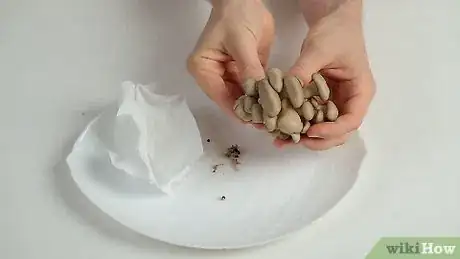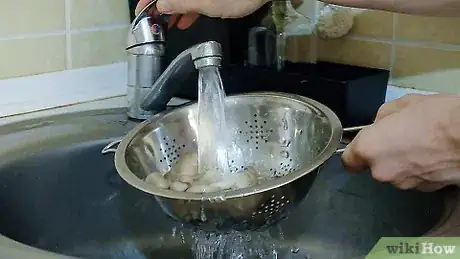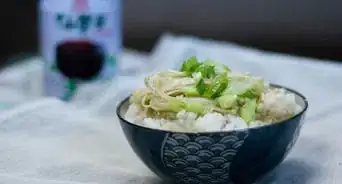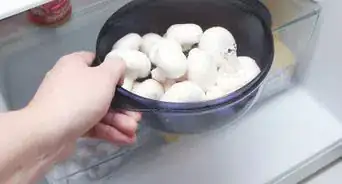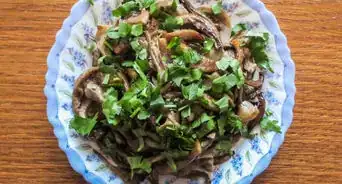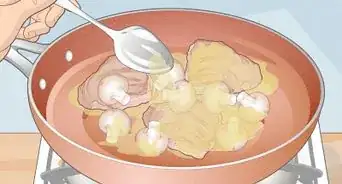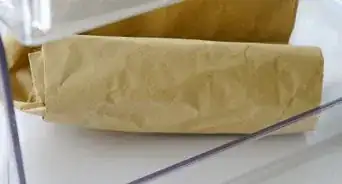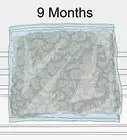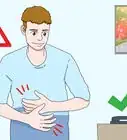This article was co-authored by Ollie George Cigliano. Ollie George Cigliano is a Private Chef, Food Educator, and Owner of Ollie George Cooks, based in Long Beach, California. With over 20 years of experience, she specializes in utilizing fresh, fun ingredients and mixing traditional and innovative cooking techniques. Ollie George holds a BA in Comparative Literature from The University of California, Berkeley, and a Nutrition and Healthy Living Certificate from eCornell University.
This article has been viewed 40,708 times.
Oyster mushrooms get their name from their gray and brown oyster-like caps. They are also sometimes called oyster caps, tree mushrooms, summer oyster mushrooms, tree oyster mushrooms, or shimeji. To clean them, you can either brush or scrape off dirt, and rinse them just before cooking if desired. Make sure to carefully select oyster mushrooms and store them properly to maximize their lifespan. You can get oyster mushrooms year-round at many supermarkets, Asian markets, or specialty food shops.
Steps
Removing Dirt and Stems
-
1Brush off lightly-soiled oyster mushrooms with a paper towel. Pick up a mushroom and brush it off on all sides with a dry paper towel to remove loose dirt. Repeat this for each mushroom to clean them all.[1]
- A light brushing with a paper towel will often be enough to clean the dirt off oyster mushrooms before using them.
- You can also use a clean dry or slightly damp cloth to wipe off dirt instead of a paper towel.
Tip: Oyster mushrooms grow on trees in the wild, or in mulch if cultivated. They are a relatively clean variety of mushroom that won’t usually have a lot of dirt on them for you to clean off.
-
2Use the edge of a knife to gently scrape off stuck-on dirt. Hold a small, sharp knife, like a paring knife, in your dominant hand. Pick up a mushroom with your other hand and use the sharp edge of the knife to carefully scrape off any dirt that is stuck to the mushroom.[2]
- You can also cut off any particularly dirty parts, such as the bottom of the main stem if it is still attached.
Advertisement -
3Cut the mushrooms off the central stem prior to using them. Oyster mushrooms grow in clusters around a thicker central stem. Cut off the smaller individual stems and caps from the thick main stem and discard it.[3]
- You can save the main stem and use it to make something like stock for a soup, but it does not have a desirable flavor for eating itself.
- Cut off any parts of the mushrooms that are slimy, mushy, or have black spots as well.
-
4Rinse the mushrooms right before using them if they are still dirty. Place the mushrooms in a colander or strainer and rinse them under cool running water. Shake the strainer or colander to drain the excess water.[4]
- If you have a salad spinner, you can use it to spin the mushrooms dry after you rinse them.
- If you picked wild mushrooms, inspect them for dirt and insects carefully and always rinse them before using. Pay special attention to the gills where dirt and insects may be hidden.
-
5Avoid soaking mushrooms when cleaning them. Mushrooms are like sponges, so they will soak up water if you leave them sitting in it. Rinse them just enough to wash off any dirt, if you need to use water to clean them, and never let them soak in water.[5]
- Even rinsing mushrooms will cause them to absorb a little bit of water, but not enough to make any kind of a difference in cooking.
- Make sure they are completely dry before using them for cooking.
Selecting and Storing the Mushrooms
-
1Buy mushrooms from a loose bin instead of pre-packaged if possible. This will allow you to examine them and choose the freshest mushrooms. Fresh oyster mushrooms will last longer and taste better.[6]
- Oyster mushrooms are extremely perishable, so it’s important to choose the freshest ones, especially if you don’t plan to use them all immediately.
Tip: As an alternative to buying oyster mushrooms, you can grow them at home relatively easily.
-
2Avoid moist or slimy mushrooms. Wet mushrooms will go bad quickly. Pick up each oyster mushroom you are considering buying and don’t buy any that are damp or slimy to the touch.[7]
- If you have to buy pre-packaged oyster mushrooms, then look closely at the packages and don’t choose a package that has a lot of moisture, such as droplets of water, inside of it.
-
3Select mushrooms with firm, dry caps and stems. Pick up each mushroom and lightly squeeze the caps and stems with your fingertips. Choose oyster mushrooms that are firm and dry to the touch.[8]
- If any mushrooms feel powdery or look shriveled, then they are too dry.
-
4Choose oyster mushrooms that are 1.5 in (3.8 cm) in diameter or less. This means the mushrooms are young and the best for cooking. Larger mushrooms are also fine to eat, but the smaller young ones are ideal.[9]
- There are many different ways to use oyster mushrooms in recipes, including stir frying, roasting, sauteing, or putting them in soups and stews.
-
5Store oyster mushrooms in a paper bag in the refrigerator for up to 3 days. A paper bag is the best way to keep mushrooms ventilated and dry in the fridge so they last the longest. Use a plastic bag and leave it open to allow air in if you don’t have a paper bag.[10]
- Oyster mushrooms generally last up to about 3 days if you select ones that are in their prime and store them properly. However, check them before cooking with them and don’t use any that are wet, slimy, or have developed dark spots.
Things You'll Need
Removing Dirt and Stems
- Paper towel
- Knife
- Water
- Strainer
- Salad spinner (optional)
Selecting and Storing the Mushrooms
- Paper bag
- Refrigerator
References
- ↑ https://www.bonappetit.com/test-kitchen/ingredients/article/oyster-mushroom-2
- ↑ https://www.bonappetit.com/test-kitchen/ingredients/article/oyster-mushroom-2
- ↑ https://www.seriouseats.com/2014/10/knife-skills-how-to-clean-shiitake-portobello-oyster-mushrooms.html
- ↑ https://www.seriouseats.com/2014/10/knife-skills-how-to-clean-shiitake-portobello-oyster-mushrooms.html
- ↑ https://www.thekitchn.com/survey-do-you-wash-your-mushro-43391
- ↑ https://www.seriouseats.com/2014/10/knife-skills-how-to-clean-shiitake-portobello-oyster-mushrooms.html
- ↑ https://www.bonappetit.com/test-kitchen/ingredients/article/oyster-mushroom-2
- ↑ https://www.bonappetit.com/test-kitchen/ingredients/article/oyster-mushroom-2
- ↑ https://www.bonappetit.com/test-kitchen/ingredients/article/oyster-mushroom-2
